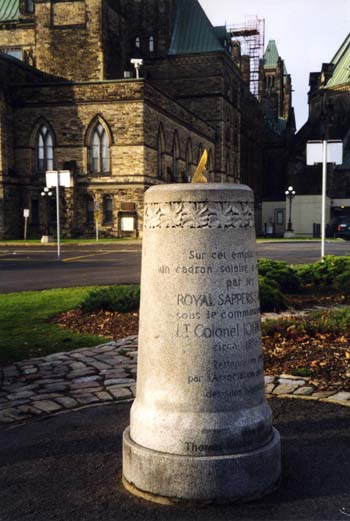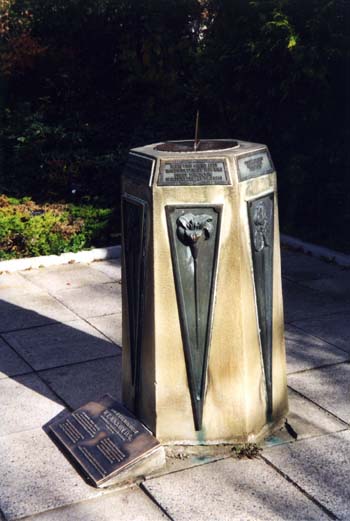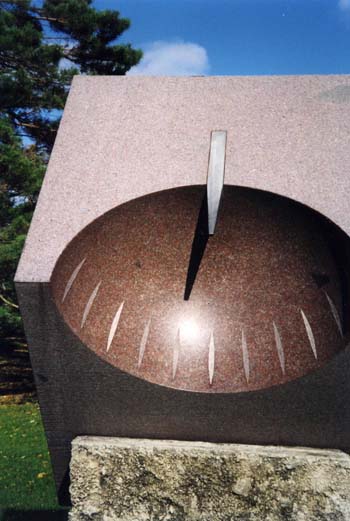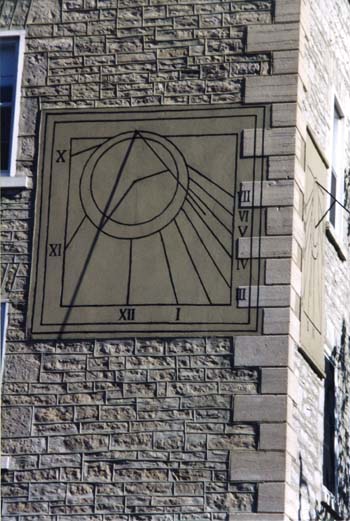This sundial trail is dedicated, by permission, to Her Excellency Diana
Fowler LeBlanc.
Ottawa has a number of interesting sundials, and the trail takes you round
the most interesting parts of the city to see them. The trail is best
done by bicycle; the city is well served with bike trails, and there is
a very good bike rental service called RentABike
at the back of the Chateau Laurier in the city centre. They will give
you a cycle map of Ottawa too!

Return to the Rideau Canal. You can cycle down either bank;
the far (east) bank is slightly shorter. Ride about 6.5 km to
the lock at the far side of Dow’s Lake. From the west bank by
the lock, take the road from the far left corner of the car park.
This goes straight across Prince of Wales drive at some traffic
lights. After 200 m. turn right at a T-junction. You are now passing
through the grounds of the Central Experimental Farm. After a
group of buildings on your right, you reach a -junction at the
top of the hill. Turn right at the top of the hill, and after
100 m. turn right into the car park for the Central Experimental
Farm. There is an ornamental garden on your left, and in it a
memorial sundial to W T Macoun, D.Sc. who was the first Dominion
Horticulturist, and held the post from 1910 to 1938.
|
The first sundial is between the Parliament Building
and the Ottawa River. There is a cliff-top walk with panoramic views
of the river, with a number of statues to notable figures in the
history of Canada. Only one of these statues commemorates two people
- it is at the downstream end, and is a memorial to Baldwin and
LaFontaine. Just next to it is a nice horizontal dial commemorating
Colonel By, who founded Bytown as a construction camp for the building
of the Rideau Canal; Bytown later became Ottawa, and was chosen
as the federal capital of Canada because it was on the border between
Upper Canada (now Ontario) and Lower Canada (now Quebec), and avoided
choosing either Toronto or Montreal! It also had the advantage of
being much further from the border with the United States, and thus
less at risk from an American attack.

|
Return to the Driveway and turn left, retracing your path back to the
T-junction and a little beyond it, where you turn right into a road which
becomes Observatory Crescent. This leads up to Carling Avenue, and, just
before you get there, you will see the buildings of the first Dominion
Observatory with its verdigris copper dome. Just outside it is a most
interesting floral sundial. The hour lines are the concrete divisions
between the wedge-shaped beds, and the gardeners continue to do an excellent
job in planting suitably different and interesting plants in each segment.
The gnomon, however, is in a very sad state - it has been bent in at least
three places, and is no longer capable of casting a straight shadow at
all!
Now, you retrace your path to the lock on the Rideau
Canal. If you feel reasonably energetic, continue on the east bank of
the canal a further 1.5 km to the Hogs Back Falls. There are two tunnels
under the Hogs Back Road to take you safely to the east bank of the
Rideau River which again has a bike track along it. This track passes
through a variety of landscapes, laced with occasional main roads, and
after some 10 km you reach the Rideau Falls where the Rideau joins the
Ottawa River. On your right is the handsome mansion of the French Ambassador,
and in front of it, the Max Florence memorial sundial, a large cube
of granite with a hemisphere scooped out of its top edge to form the
dial plate of a sundial. Max Florence sent his life savings to Premier
Pierre Trudeau in 1975 to say thank you for the blessings he had enjoyed
since emigrating to Canada, and the money was put towards making this
very unusual and interesting sundial. There is also a large sphere representing
the globe with lines of latitude and longitude and an eagle on top.
It Is a memorial to Commonwealth pilots,
 |
 |
At this point, you can divert to see Rideau Hall, the residence of the
Governor-General.
Cross the Rideau Falls on the Sussex Drive bridge (and probably get mist
droplets from the falls all over you). Continue along Sussex Drive to
the Royal Mint on your right. Opposite it is an excellent traditional
French corner sundial on the Sister of Charity Convent. It has declining
dials on the two adjoining faces of the building.
Continue on down Sussex. When you get to the new National Gallery of Canada
on your right, it is worth heading towards the Ottawa River, keeping the
gallery on your right, to the Major Hill Park. There is a statue of Champlain,
the explorer, using an astrolabe (though I am told he is not doing it
quite right!). Also in this park, there used to be a noon cannon set off
by the sun focused through a magnifying glass, but there is no trace of
it now. Any news of what happened to it would be appreciated.

After you have returned your bicycles, there is one further sundial which
is worth visiting, but it is best done by car or bus. It is at the
National Museum of Science and Technology , and it is hoped that it
will shortly be exhibited in the front area of the Museum, so you do not
even need to pay to see it. (You can find out whether it is on exhibit
on (613) 990 2804. (However, it is well worth going round the museum for
all the fascinating exhibits they have). From downtown Ottawa, visitors
would take #86 (Elmvale) bus (or less direct but more frequent #85 (Baseline))
to Elmvale Shopping Centre. One can also use buses on the transitway to
get to St. Laurent Shopping Centre (e.g. #95 (Orleans)) and then take
#85 (Bayshore) or 111 (Baseline).
Acknowledgement: this sundial trail built on foundations kindly suggested
by Roger Bailey of Walking Shadow Designs in Canmore, Alberta. Roger is
a frequent visitor to Ottawa, and enjoys exploring the cultural traditions
and gnomonic science of sundial design and construction.
|
 For
a full overview click
here
For
a full overview click
here  For
a full overview click
here
For
a full overview click
here